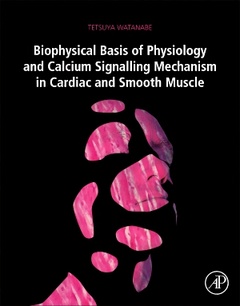Description
Biophysical Basis of Physiology and Calcium Signaling Mechanism in Cardiac and Smooth Muscle
Author: Watanabe Tetsuya
Language: English
Subject for Biophysical Basis of Physiology and Calcium Signaling...:
Keywords
Acetylcholinesterase; Activation energy; Adrenergic receptors; Afterdepolarization; Agonists and antagonists; Antiarrhythmic drugs; ATP-coupled reaction; Atrioventricular reentrant tachycardia; Automaticity; Boltzmann distribution; Ca2+ oscillation; Calmodulin; Cardiac output; Cerebral blood flow; Channels and transporters; Coenzyme; Conditions of spontaneity; Cyclic AMP; Degeneracy; Derivation of Nernst equation; Diffusion; Diffusion through the membrane; ECG; Electron affinity; Electron transport and ATP production; Electronegativity; Entropy and diffusion; Facilitated diffusion; Fick's law of diffusion; Flux; Free radicals; Functionally defined reentrant tachycardia; Funny currents; G protein-coupled receptor; Gas exchanges; Glycosylation; Goldman equation; Hyperpolarization-activated funny current; Interacting system; Inwardly rectifying channel; IP3-gated Ca2+ channel; Ligand-gated ryanodine receptors; Microstate; Modulator of cardiac automaticity; Muscarinic receptor; Mutations; Myocardial ischemia; Na+-Ca2+ exchanger; Neuronal communication; Osmotic pressure; Oxidation-reduction reaction; Oxidative phosphorylation; Pacemaker or pacemaker-like cells; Partition functions; Polar molecule; Pulmonary resistance and compliance; Purikinje cells; Purinergic receptor; Regenerative discharge of stored Ca2+; Second messengers; Shielding effect; Stabilization of signal; Transcription and translation; Transmembrane proteins; Transporter; Vectors and transfection; Ventricular fibrillation; Voltage-gated Ca2+ channel; Wolff-Parkinson-White syndrome
232 p. · 19x23.3 cm · Paperback
Description
/li>Contents
/li>Readership
/li>Biography
/li>Comment
/li>
Biophysical Basis of Physiology and Calcium Signaling Mechanism in Cardiac and Smooth Muscle acts as a bridge between physiology and physics by discussing the physiology and calcium signaling mechanism in cardiac and smooth muscle. By exploring the mechanism of the cyclic release of stored Ca^(2+) in the SR or ER, this book covers the cell communication system, including excitable cells, recognizing the most relevant mechanisms of cell communication. Serving as a bridge between physiology and physics, coverage spans the physiology and calcium signaling mechanism in cardiac and smooth muscle, offering insight to physiological scientists, pharmaceutical scientists, medical doctors, biologists and physicists.
1. Introduction2. Statistical Thermodynamics3. Shielding Effect and Chemical Bonding4. The Cell5. Diffusion and Flow, and Respiratory System6. Peripheral Nervous Systems7. Calcium Signaling in Heart and Small Intestine8. Mechanism of Cardiac Arrhythmias and Antiarrhythmic Drugs
Physiological Scientists, Pharmaceutical Scientists, and Medical Doctors, Biologists, Physicists
Dr. Watanabe is the recent author of Biophysical Basis of Physiology and Calcium Signaling Mechanism in Cardiac and Smooth Muscle, published by Elsevier/Academic Press in 2018.
- Explores the mechanism of the cyclic release of stored Ca^2+ in the SR or ER
- Provides in-depth coverage of cell communication systems to explain the most relevant mechanisms of cell communication
- Covers the physiology and calcium signaling mechanism in cardiac and smooth muscle
These books may interest you

Vascular PharmacologySmooth Muscle 202.15 €



